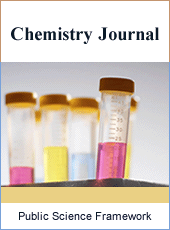Chemistry Journal
Articles Information
Chemistry Journal, Vol.1, No.2, Apr. 2015, Pub. Date: Mar. 25, 2015
Silver Nanoparticles Effect on Silicon Nanowires Properties
Pages: 10-14 Views: 3466 Downloads: 2117
[01]
R. Benabderrahmane Zaghouani, Photovoltaic Laboratory, Research and Technology Centre of Energy, BorjCedria Science and Technology Park, Hammam-Lif, Tunisia.
[02]
S. Aouida, Photovoltaic Laboratory, Research and Technology Centre of Energy, BorjCedria Science and Technology Park, Hammam-Lif, Tunisia.
[03]
N. Bachtouli, Photovoltaic Laboratory, Research and Technology Centre of Energy, BorjCedria Science and Technology Park, Hammam-Lif, Tunisia.
[04]
B. Bessais, Photovoltaic Laboratory, Research and Technology Centre of Energy, BorjCedria Science and Technology Park, Hammam-Lif, Tunisia.
Thiswork focuses on optical characterization of silicon nanowires (SiNWs) used for photovoltaic applications. We report on the elaboration of silicon nanowires by Metal Assisted Chemical Etching (MACE) technique using silver (Ag) as metal catalyst. The obtained resultsshow that the SiNWsoptical properties are sensitive to their elaboration conditions specially the cleaning protocol. The reflectivity was found to be dependent on wavelength and increased from ultra-violet to red wavelength for all tested samples. The comparison between samples with different cleaning protocol shows that, in the UV spectral region, SiNWsmore contaminated with Ag nanoparticles present a pronounced decrease of the reflectivity. This optical behavior was attributed to metallic nanoparticles persisting in the silicon nanowires structures presenting surface plasmon resonance energy in a vicinity of UV spectral region.
SiNWs, MACE, Reflectivity, Silver Nanoparticles, Surface Plasmon Resonance
[01]
Green MA. Crystalline and thin-film silicon solar cells: state of the art and future potential. Sol. Energy 2003; 74:181-192
[02]
Green MA. Photovoltaics: technology overview. Energy Policy 2000; 28: 989-998
[03]
Green MA. Thin-film solar cells: review of materials, technologies and commercial status. J. Mater. Sci: Mater Electron 2007; 18: S15-S19
[04]
Kang MH,RyuK, Upadhyaya A, Rohatgi A. Optimization of SiN AR coating for Si solar cells and modules through quantitative assessment of optical and efficiency loss mechanism. Prog. Photovolt: Res. Appl 2011; 19: 983-990
[05]
Bachtouli N, Aouida S, HadjLaajimi R, Boujmil MF, Bessais B. Implications of alkaline solutions-induced etching on optical and minority carrier lifetime features of monocrystalline silicon. Appl. Surf. Sci 2012; 258: 8889-8894
[06]
Macdonald DH, Cuevas A, Kerr MJ, Samundsett C, Ruby D, Winderbaum S, Leo A. Texturing industrial multicrystalline silicon solar cells. Sol. Energy 2004; 76: 277-283
[07]
Sopori BL, Pryor RA.Design of antireflection coatings for textured silicon solar cells. Solar Cells 1983; 8: 249-261
[08]
Chiao SC, Zhou JL, Macleod HA.Optimized design of an antireflection coating for textured silicon solar cells. Appl. Opt 1993; 32: 5557-5560
[09]
Richards BS. Comparison of TiO2 and Other Dielectric Coatings for Buried-contact Solar Cells: a Review. Prog.Photovolt: Res. Appl 2004; 12: 253-281
[10]
Chen KI, Li BR, Chen YT.Silicon nanowire field-effet transistor-based biosensors for biomedical diagnosis and cellular recording investigation. Nano Today 2011; 6: 131-154
[11]
Lu N, Gao A, Dai P, Wang Y, Gao X, Song S, Fan C, Wang Y. Ultra-sensitive nuclei acids detection with electrical nanosensors based on CMOS-compatible silicon nanowire field-effect transistors. Methods 2013; 63: 212-218
[12]
Bullis WM. Properties of gold in silicon. Solid-State Electronics 1996; 9: 143-168
[13]
Bai F, Li M, Song D, Yu H, Jiang B, Li Y. One-step synthesis of lightly doped porous silicon nanowires in HF/AgNO3/H2O2 solution at room temperature. Journal of Solid State Chemistry 2012; 196: 596-600
[14]
Smith ZR, Smith RL, Collins SD. Mechanism of nanowires formation in metal assisted chemical etching. Electrochimica Acta 2013; 92:139-147
[15]
Qiu T, Wu XL, Yang X, Huang GS, Zhang ZY.Self-assembled growth and optical emission of silver-capped silicon nanowires.App. Phys. Lett 2004; 84: 3867
[16]
Peng KQ, Yan YJ, Gao SP, ZhuJ. Dendrite-assited growth of silicon nanowires in electroless metal deposition. Adv. Function. Mater 2003;13: 16
[17]
Peng KQ, Wu Y, Fang H, Zhong X, Xu Y, Zhu J.Uniform, Axial- Orientation Alignement of One Dimensional Single-Crystal Silicon Nanostructure Arrays. Angew. Chem. Int. Ed 2005; 44: 2737
[18]
RazaaS, Stengera N, Kadkhodazadeh S, Fischer SV, Kostesha N, Jauho AP, Burrows A, Wubs M, Mortensen NA. Blueshift of the surface plasmon resonance in silver nanoparticles: substrate effects. Nanophotonics 2013; 2: 131–138
[19]
Atwater HA, PolmanA. Plasmonics for improved photovoltaic devices. Nature Mater 2010; 9: 205-213.

ISSN Print: 2381-7674
ISSN Online: 2381-7682
Current Issue:
Vol. 6, Issue 1, March Submit a Manuscript Join Editorial Board Join Reviewer Team
ISSN Online: 2381-7682
Current Issue:
Vol. 6, Issue 1, March Submit a Manuscript Join Editorial Board Join Reviewer Team
| About This Journal |
| All Issues |
| Open Access |
| Indexing |
| Payment Information |
| Author Guidelines |
| Review Process |
| Publication Ethics |
| Editorial Board |
| Peer Reviewers |


